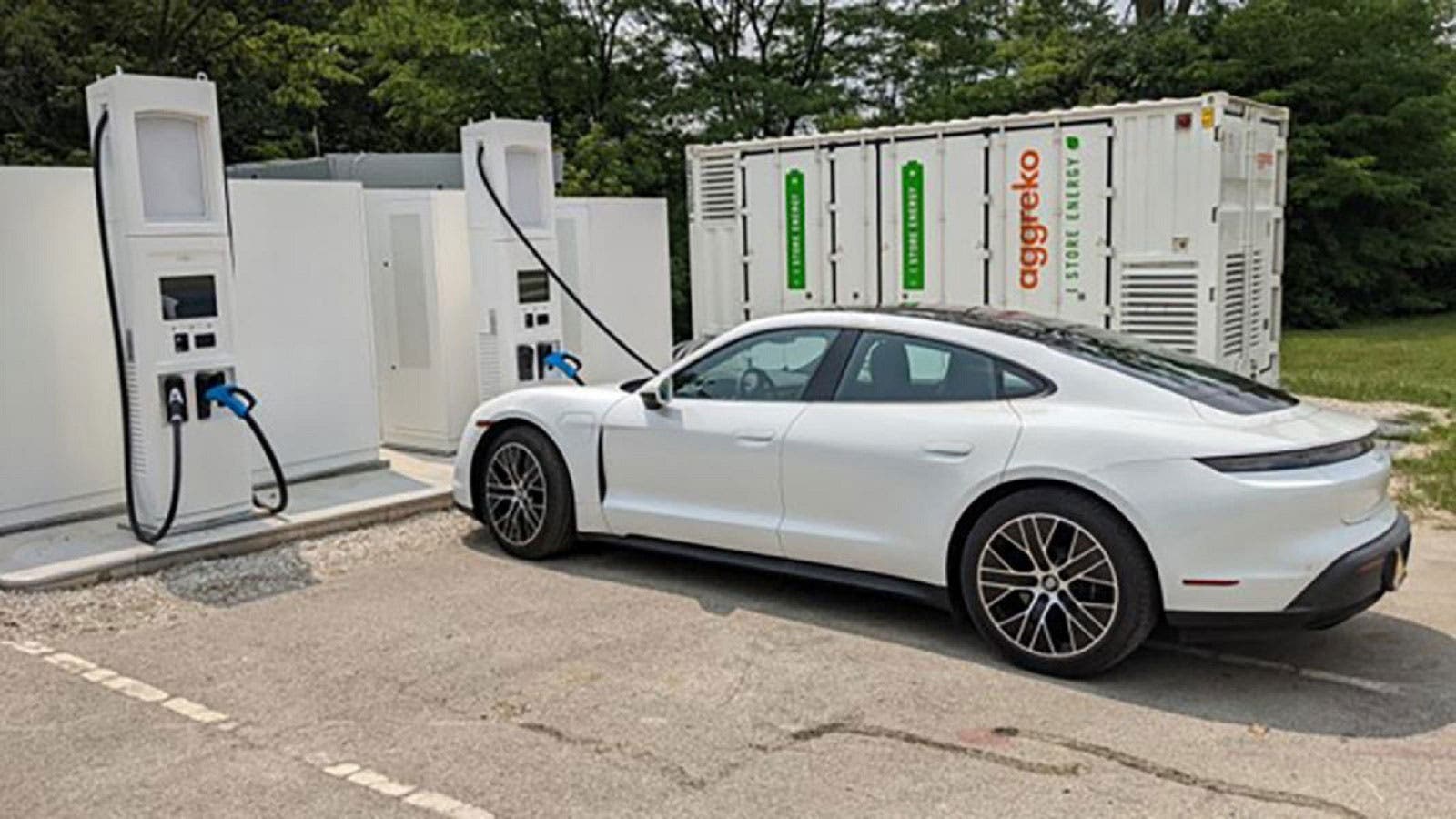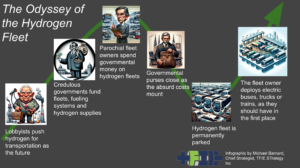As more electric vehicles (EVs) hit the road, charging stations are popping up across the United States. The benefits go beyond curbing carbon emissions from road travel. These systems can also link to the electric grid through smart charging, drawing power when overall demand is low and feeding it back to the grid when needed.

Argonne researchers evaluated different charging technologies and setups at the Smart Energy Plaza, pictured, a testbed for connecting EV charging, renewable energy, building systems, and energy storage. (Image by Argonne National Laboratory.)
Any digital device needs cybersecurity precautions, and connected vehicle chargers are no exception. Researchers at the U.S. Department of Energy’s (DOE) Argonne National Laboratory, in collaboration with Exelon, the nation’s largest utility company are preparing for a secure smart-charging future as part of a four-year, $5 million project funded by DOE’s Vehicle Technologies Office within the Office of Energy Efficiency and Renewable Energy.
“The work that we are doing is giving us an idea of the potential pitfalls, and where to go next, as more of these systems come online.” — Dan Dobrzynski, research engineer
Computer networks enable the on-demand charging that will allow EVs to bolster the grid. That requires some smart charging stations to be more than some outlets and wiring — they often have wireless connectivity, hard drives and the ability to plug in keyboards and mice.
“We functionally think of these as computers on the network. What if they were compromised by someone who shouldn’t have access?” said Roland Varriale, cybersecurity analyst at Argonne. “We are looking at how we can mitigate any risks associated with that.”
Varriale and colleagues evaluated different charging technologies and setups with the help of the Smart Energy Plaza, Argonne’s testbed for integrating EV charging, renewable energy, building systems, and energy storage. They compiled known, identified vulnerabilities to EV charging systems, on demand response charging technologies, and devices such as mobile phones; and provided best practices for safeguarding them, briefing Exelon and equipment manufacturers.
“EV charging infrastructure will become critical to everyday business and the energy security of the United States,” said Dan Dobrzynski, research engineer at Argonne. “The work that we are doing is giving us an idea of the potential pitfalls, and where to go next, as more of these systems come online.”
The work with Exelon will also inform DOE’s Electric Vehicles at Scale Lab Consortium (EVs@Scale), which has a focus on cyber-physical security. The consortium brings together six DOE national research labs including Argonne to collaborate with industry, community groups and other stakeholders. The initiative’s overarching goal is to address challenges and barriers for high-power EV charging infrastructure.
“Through EVs@Scale, we are taking insights from the current project and looking at how they can be applied more broadly,” Varriale said. “By doing that, we can get well ahead of potential threats and build secure clean energy systems.”
EERE’s Vehicle Technologies Office (VTO) supports research and development (R&D) of efficient and sustainable transportation technologies that will improve energy efficiency and affordability. These technologies, which include advanced batteries and electrification, lightweight materials, advanced combustion systems and fuels, as well as energy efficient mobility systems, will increase America’s energy security, economic vitality, and quality of life.
Courtesy of Argonne National Laboratory, By CHRISTINA NUNEZ
Sign up for daily news updates from CleanTechnica on email. Or follow us on Google News!
Have a tip for CleanTechnica, want to advertise, or want to suggest a guest for our CleanTech Talk podcast? Contact us here.
Solar PV & Farming — Trends In Agrivoltaics
I don’t like paywalls. You don’t like paywalls. Who likes paywalls? Here at CleanTechnica, we implemented a limited paywall for a while, but it always felt wrong — and it was always tough to decide what we should put behind there. In theory, your most exclusive and best content goes behind a paywall. But then fewer people read it! We just don’t like paywalls, and so we’ve decided to ditch ours. Unfortunately, the media business is still a tough, cut-throat business with tiny margins. It’s a never-ending Olympic challenge to stay above water or even perhaps — gasp — grow. So …
Advertisement
- SEO Powered Content & PR Distribution. Get Amplified Today.
- PlatoAiStream. Web3 Data Intelligence. Knowledge Amplified. Access Here.
- Minting the Future w Adryenn Ashley. Access Here.
- Buy and Sell Shares in PRE-IPO Companies with PREIPO®. Access Here.
- Source: https://cleantechnica.com/2023/05/05/argonne-national-laboratory-helps-to-make-ev-charging-stations-cybersecure/
- :has
- :is
- :where
- $UP
- 1
- 39
- 9
- a
- ability
- above
- access
- across
- address
- advanced
- Advertise
- ahead
- allow
- also
- always
- an
- analyst
- and
- any
- applied
- ARE
- Argonne National Laboratory
- AS
- associated
- At
- back
- barriers
- batteries
- BE
- become
- behind
- benefits
- BEST
- best practices
- Beyond
- Bit
- bolster
- Briefing
- Brings
- broadly
- build
- Building
- business
- but
- by
- CAN
- Can Get
- carbon
- carbon emissions
- challenge
- challenges
- charging
- charging stations
- chip
- clean energy
- cleantech
- Cleantech Talk
- collaborate
- collaboration
- colleagues
- come
- community
- company
- Compromised
- computers
- connected
- Connecting
- Connectivity
- consortium
- content
- critical
- Current
- Cybersecurity
- decide
- decided
- Demand
- demand response
- Department
- Development
- device
- Devices
- different
- digital
- do
- DOE
- doing
- don
- drawing
- Economic
- efficiency
- efficient
- Electric
- electric vehicles
- Emissions
- enable
- energy
- energy efficiency
- engineer
- equipment
- Ether (ETH)
- EV
- evaluated
- Even
- everyday
- exception
- Exclusive
- farming
- feeding
- fewer
- Focus
- For
- from
- fuels
- funded
- future
- get
- Giving
- Go
- goal
- Goes
- Grid
- Group’s
- Grow
- Guest
- Hard
- Have
- help
- here
- Hit
- How
- http
- HTTPS
- idea
- identified
- if
- image
- implemented
- improve
- in
- include
- Including
- Increase
- industry
- inform
- Infrastructure
- insights
- Integrating
- IT
- jpg
- just
- known
- lab
- laboratory
- Labs
- largest
- Life
- lightweight
- like
- Limited
- LINK
- looking
- Low
- Making
- Manufacturers
- margins
- materials
- max-width
- Media
- mice
- million
- Mitigate
- Mobile
- mobile phones
- mobility
- monthly
- more
- most
- National
- Nations
- needed
- needs
- network
- networks
- New
- news
- next
- no
- of
- Office
- often
- Olympic
- on
- On-Demand
- online
- or
- Other
- our
- Outlets
- overall
- part
- Patreon
- PayPal
- People
- perhaps
- phones
- plato
- Plato Data Intelligence
- PlatoData
- please
- plug
- podcast
- potential
- power
- practices
- preparing
- project
- provided
- put
- quality
- R&D
- Read
- Renewable
- renewable energy
- requires
- research
- research and development
- researchers
- response
- risks
- road
- Roland
- s
- safeguarding
- Said
- Scale
- secure
- security
- should
- SIX
- smart
- So
- some
- Someone
- stakeholders
- States
- Stations
- stay
- Still
- storage
- such
- suggest
- support
- Supports
- sustainable
- Systems
- taking
- Talk
- team
- Technologies
- than
- that
- The
- Them
- then
- There.
- These
- they
- think
- threats
- Through
- tip
- to
- together
- transportation
- travel
- Trends
- u.s.
- United
- United States
- Updates
- us
- utility
- Ve
- vehicle
- Vehicles
- via
- Vulnerabilities
- want
- was
- Water
- we
- WELL
- were
- What
- when
- which
- while
- WHO
- will
- wireless
- with
- within
- Work
- Wrong
- you
- Your
- zephyrnet









